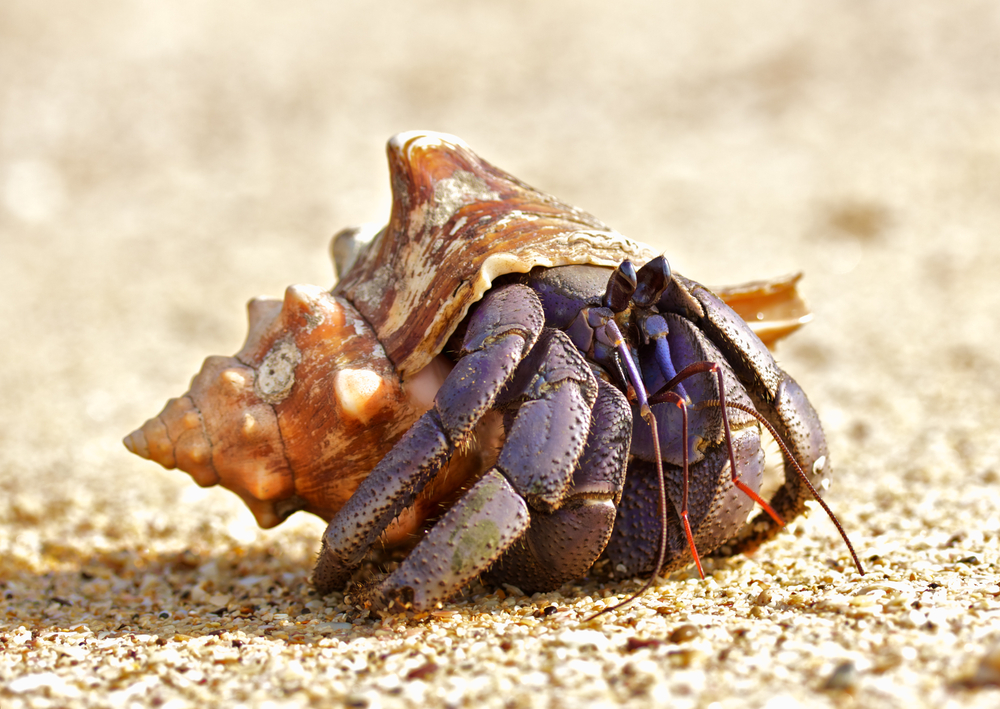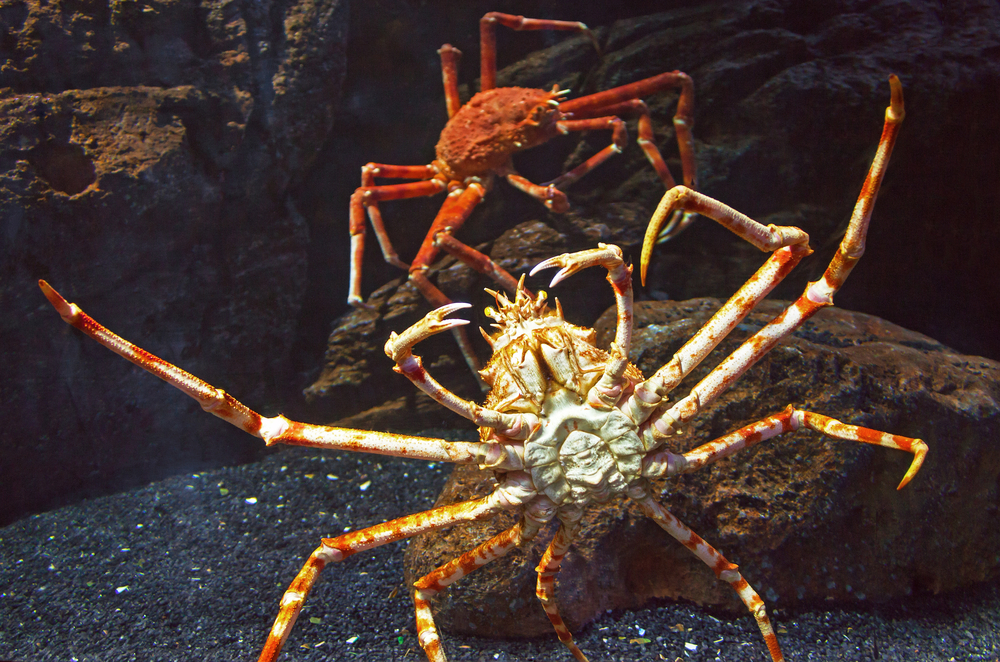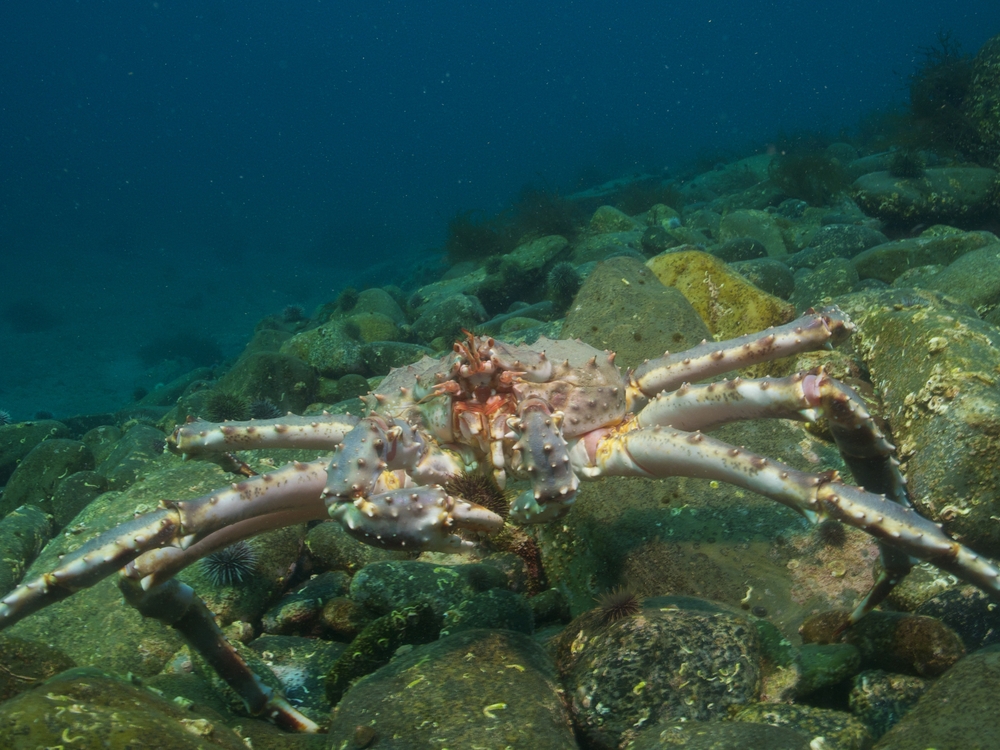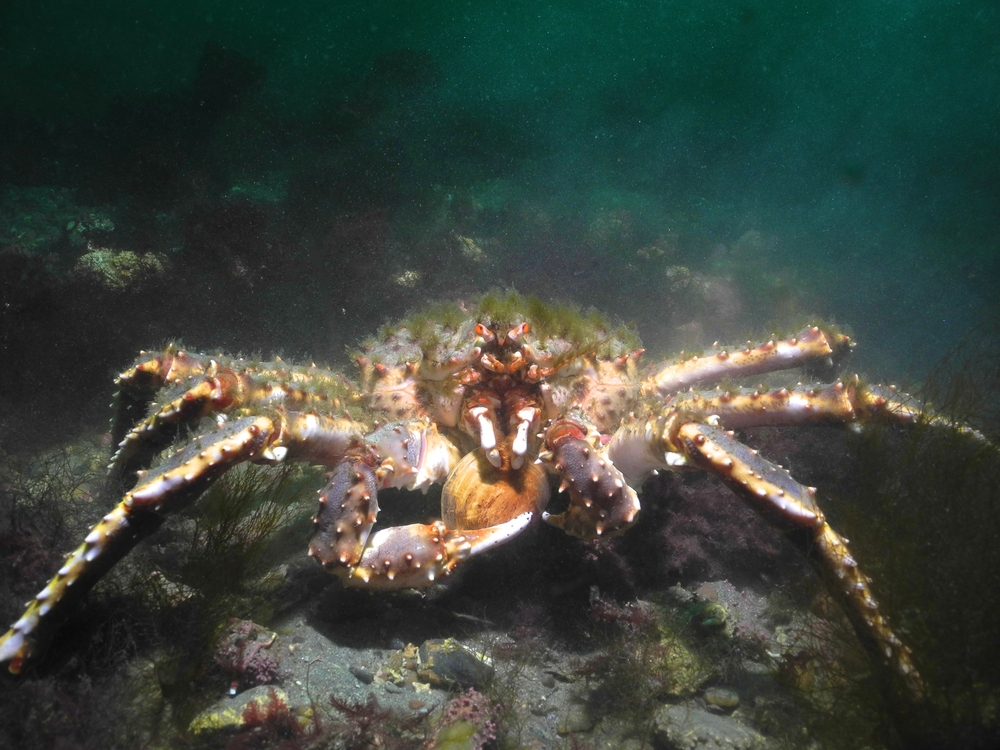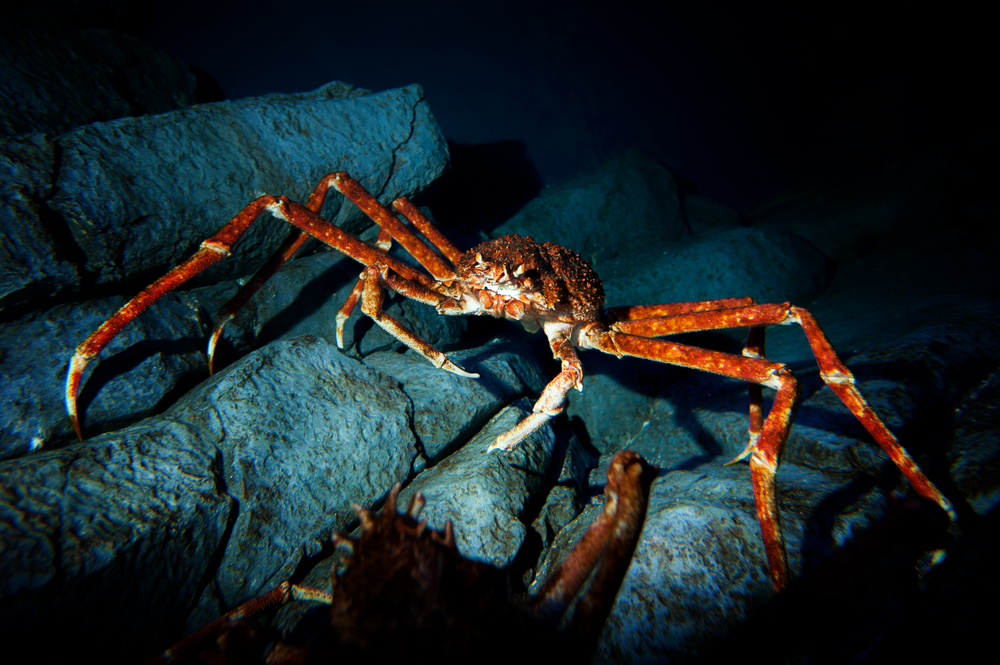About
The King Crab, scientifically known as Paralithodes camtschaticus, belongs to the Animal Kingdom’s phylum Arthropoda, class Malacostraca, and order Decapoda. It is a member of the Lithodidae family, which includes other species of king crabs found in various parts of the world, such as the snow crab and the golden king crab. King crabs are predominantly found in cold ocean waters, particularly in the North Pacific region, including the Bering Sea and the Gulf of Alaska.
These large crustaceans are known for their impressive size and distinctive appearance. They have a hard exoskeleton covering their bodies, which protects them from predators and environmental hazards. King crabs are characterized by their long, spindly legs and large claws, which they use for walking along the ocean floor and capturing prey. The body of a king crab can reach sizes of up to 24 inches (60 cm) in width, making them formidable predators in their marine habitats.
King crabs are primarily carnivorous, feeding on a variety of prey, including small fish, mollusks, and other crustaceans. They play important roles in marine ecosystems as both predators and scavengers, helping to maintain the balance of marine populations.
Conservation Concerns
King crabs are subject to commercial fishing activities due to their high market demand as seafood delicacies. Overfishing and habitat degradation pose significant threats to king crab populations, particularly in areas where fishing fleets heavily target them. Additionally, climate change and ocean acidification may impact the availability of suitable habitats for king crabs in the future.
Currently, there is no specific conservation concern status for the King Crab on the IUCN Red List. However, sustainable fishing practices and effective management strategies are essential for ensuring the long-term survival of king crab populations and maintaining healthy marine ecosystems. Efforts to minimize bycatch and protect critical habitats can help mitigate the threats facing these iconic crustaceans.
Physical Characteristics
The king crab, belonging to the family Lithodidae, encompasses several species, among which the red king crab (Paralithodes camtschaticus) is one of the most well-known and commercially significant. These crabs are found in the cold waters of the northern Pacific and Atlantic Oceans, renowned for their size and the quality of their meat. Here’s a detailed look at the physical characteristics of the king crab:
Size
- Leg Span: The leg span of king crabs can be impressive, with some individuals reaching up to 6 feet (1.8 meters) from tip to tip of their outstretched legs.
- Weight: They can weigh up to 24 pounds (around 11 kilograms), though the average weight is generally between 6 to 10 pounds (2.7 to 4.5 kilograms).
Physical Characteristics
- Body: The body of a king crab, also known as the carapace, is covered with a hard exoskeleton to protect it from predators. The carapace is wide and spiky, with a heart-shaped appearance when viewed from above.
- Color: The coloration of king crabs can vary by species. The red king crab, as its name suggests, has a vibrant red or burgundy color on its shell, which turns bright red when cooked. Other species, like the blue king crab, have a bluish hue on their shells.
- Legs: King crabs have three pairs of walking legs and one pair of claw-bearing legs (chelipeds), which are used for feeding and defense. One of the claws is typically larger and stronger, used for crushing, while the other is smaller and sharper, used for cutting. The walking legs are long and powerful, aiding in their movement across the ocean floor.
- Tail: Unlike other crabs, the abdomen of the king crab is very small and usually tucked under its body, not visible from above.
- Eyes: Their eyes are small and situated on stalks, providing them with a wide field of vision.
- Gills: King crabs breathe through gills, which are located under the carapace near the base of the legs.
King crabs are bottom dwellers, often found in cold, deep waters ranging from shallow intertidal zones to depths of 2,000 feet (610 meters) or more. They are opportunistic feeders, consuming a diet that includes fish, smaller crustaceans, mollusks, and sometimes even other king crabs. The combination of their distinctive physical characteristics, ecological role, and economic value makes king crabs a prominent species in the marine environments they inhabit.
Reproduction
King crabs, with their formidable size and unique reproductive strategies, have a distinctive reproductive cycle adapted to their marine environment. Here’s an overview:
Breeding Season: King crabs typically mate during the spring and summer months when water temperatures are optimal for spawning. Breeding seasons can vary depending on the species and geographical location.
Mating Behavior: Male king crabs compete for access to females during the breeding season. Mating often occurs in shallow coastal waters, where males use their powerful claws to engage in aggressive encounters with rivals and court receptive females.
Spawning and Egg Development: After mating, female king crabs migrate to deeper waters to release their eggs. Each female can produce thousands to millions of eggs, which are fertilized externally by the male’s sperm. The eggs are carried by ocean currents and undergo development over several weeks.
Larval Stage: King crab eggs hatch into larvae known as zoea, which are planktonic and drift with ocean currents. During this stage, the larvae undergo molting as they grow and develop into more advanced stages.
Settlement and Juvenile Growth: As the larvae mature, they undergo a metamorphosis and settle to the ocean floor. Here, they transition into juvenile crabs and begin their benthic lifestyle. Juvenile king crabs undergo several molts as they grow, gradually acquiring the characteristic features of adults.
Maturation and Reproductive Maturity: King crabs reach sexual maturity after several years of growth, typically around 5 to 7 years old, depending on species and environmental conditions. Once mature, they participate in the annual breeding migrations to reproduce and perpetuate the species.
Life Cycle Dynamics: The reproductive cycle of king crabs is intricately linked to environmental factors such as water temperature, salinity, and food availability. Understanding their reproductive biology is crucial for managing sustainable fisheries and conserving king crab populations in their natural habitats.
By studying the reproductive cycle of king crabs, scientists can gain insights into their population dynamics, reproductive success, and responses to environmental changes. Conservation efforts aimed at protecting king crab populations must consider their unique life history traits and habitat requirements to ensure their long-term survival in marine ecosystems.
Lifespan
King crabs are large crustaceans found in cold waters around the world, known for their size and distinctive spiky shells. Understanding their lifespan and the threats they face is crucial for managing their populations sustainably.
Lifespan in the Wild: In the wild, the lifespan of king crabs varies depending on species, environmental conditions, and predation pressures. On average, most king crab species live for around 10 to 20 years, although some individuals may live longer under favorable conditions.
Lifespan in Captivity: King crabs can live longer in captivity compared to the wild, provided they receive proper care, habitat conditions, and nutrition. In controlled environments such as aquariums or research facilities, king crabs may live for several decades, with some individuals reaching ages of 30 years or more.
Threats to the King Crab:
- Overfishing: Overfishing is a significant threat to king crab populations, particularly in commercial fisheries. Unsustainable harvesting practices, such as high fishing quotas, illegal fishing, and bycatch, can lead to population declines and ecosystem imbalances.
- Habitat Destruction: Habitat destruction from human activities such as bottom trawling, dredging, and seabed mining can damage king crab habitats, disrupt breeding grounds, and reduce food availability. Destruction of essential habitat features like rocky reefs and kelp forests can negatively impact king crab populations.
- Climate Change: Climate change poses multiple threats to king crabs, including rising sea temperatures, ocean acidification, and changes in ocean currents and food availability. These environmental changes can affect king crab physiology, reproduction, and larval survival, leading to population declines and distribution shifts.
- Pollution: Pollution from industrial activities, oil spills, and coastal development can contaminate king crab habitats and expose them to toxic chemicals. Pollution can impair king crab health, reproductive success, and immune function, increasing susceptibility to diseases and other stressors.
- Predation: King crabs face predation from various marine predators, including fish, octopuses, and other crustaceans. Predatory pressure can limit king crab populations, particularly juveniles and smaller individuals, affecting population dynamics and ecosystem structure.
- Illegal Harvesting: Illegal harvesting of king crabs, often driven by high market demand and lucrative prices, can lead to overexploitation and population depletion. Illegal fishing practices, such as poaching in restricted areas or undersized harvesting, can undermine conservation efforts and threaten the sustainability of king crab populations.
Conservation efforts for king crabs include implementing sustainable fishing practices, protecting critical habitats, monitoring population trends, and enforcing regulations to prevent overfishing and illegal harvesting. Research on king crab biology, ecology, and habitat requirements is essential for informed management decisions and the long-term conservation of these valuable marine species.
Eating Habits
King crabs are large marine crustaceans known for their impressive size and delicious meat. They are primarily bottom-dwellers and are found in cold waters around the world, particularly in the northern Pacific Ocean.
Diet: King crabs are omnivorous scavengers, meaning they consume a variety of plant and animal matter found on the ocean floor. Their diet includes small fish, mollusks, worms, other crustaceans, algae, and detritus. They are opportunistic feeders and will consume whatever food source is available to them.
Feeding Behavior: King crabs use their strong claws to crack open shells and crush the hard exoskeletons of their prey. They are equipped with powerful jaws that allow them to tear apart flesh and extract nutrients from their food. They are also capable of filter-feeding, where they use specialized appendages to capture plankton and other small organisms from the water column.
Foraging and Hunting: King crabs are primarily scavengers, feeding on dead or decaying organisms that sink to the ocean floor. They use their keen sense of smell to detect potential food sources and are attracted to the scent of decaying matter. Additionally, they may actively search for food by crawling along the ocean floor or digging through sediment in search of buried prey.
Other Considerations: While king crabs are known for their large size and formidable appearance, they are also an important food source for many predators, including fish, octopuses, and seals. Additionally, they are commercially harvested for their meat, which is considered a delicacy in many parts of the world. Despite their popularity as a food item, overfishing and habitat destruction have led to declines in king crab populations in some regions. Therefore, sustainable management practices are essential to ensure the long-term viability of these species.
Uniqueness
King crabs, also known as stone crabs or Alaskan king crabs, belong to the family Lithodidae and are renowned for their large size, distinctive appearance, and culinary value. Here are some key aspects that make king crabs unique:
Impressive Size: King crabs are among the largest crustaceans in the world. They can have leg spans of up to 1.8 meters (6 feet) and weigh over 10 kilograms (22 pounds). Their sheer size makes them a formidable presence in their marine habitats.
Distinctive Appearance: King crabs have a unique appearance characterized by their large, spiny bodies and long, powerful legs. Their shells are typically reddish-brown or dark brown in color and are covered in sharp spines and knobs, providing protection from predators.
Habitat: King crabs are primarily found in cold, deep waters, particularly in the North Pacific Ocean and the Bering Sea. They inhabit rocky or muddy bottoms at depths ranging from 20 to 200 meters (65 to 656 feet), although some species can be found at greater depths.
Feeding Habits: King crabs are omnivorous scavengers, feeding on a variety of prey including fish, mollusks, worms, and other crustaceans. They are also known to scavenge on carrion and detritus found on the ocean floor.
Commercial Importance: King crabs are highly valued in the seafood industry for their delicious meat, which is tender, sweet, and flavorful. They are harvested commercially for human consumption and are considered a delicacy in many parts of the world, particularly in Asia and North America.
Reproduction: King crabs have a complex reproductive cycle. Females carry fertilized eggs on their abdomen until they hatch into planktonic larvae, which then undergo several molts before settling to the ocean floor as juveniles. The larvae are vulnerable to predation during this stage, and only a small percentage survive to adulthood.
Environmental Impact: Overfishing and habitat destruction have led to declines in some king crab populations, prompting fisheries management efforts to regulate harvests and protect critical habitats. Climate change and ocean acidification are also emerging threats to king crabs and their ecosystems.
Cultural Significance: King crabs hold cultural significance in indigenous communities in Alaska and other regions where they are harvested. They are an important source of food, income, and cultural identity for these communities, and traditional harvesting practices are often passed down through generations.
Despite their formidable appearance and economic importance, king crabs are vulnerable to various threats, highlighting the need for sustainable management practices to ensure their long-term survival and the health of their marine habitats.
Related Family Species
Sources
- Burnie, David & Wilson, Don, Animal, Smithsonian Institute, Washington DC.
- Hickman et al, Integrated Principle of Zoology, McGraw Hill, Boston.
































































